Aero Evacuation: lifesaving missions with military aircraft

Medicalised aircraft such as the Airbus C295 are indispensable tools for crisis evacuation and the transport of critically ill patients.
October 2022. A Hospital in Tenerife. A patient undergoes cardiac surgery to insert an intra-aortic balloon pump, a circulatory support device. The person being operated on, weighing about 100 kilos, suffers a complication that requires transfer to a hospital specialised in complex cardiovascular surgery.
The Spanish Air Force's Aero Evacuation Medical Unit (UMAER), located at the Torrejón base (Madrid), receives the call from the Chief of Staff office, which has approved the request from the hospital. In just two hours, the team configures a C295 aircraft for medical evacuation (Medevac) and flies to Tenerife airport. The patient is waiting on the tarmac on a stretcher connected to two complex systems: the console that regulates the counterpulsation balloon and an Extracorporeal Membrane Oxygenation System (ECMO). The patient and all additional mechanical ventilation equipment is brought into the aircraft through the tailgate. The C295 quickly takes off and flies to Gran Canaria island, and then continues the transfer by road to the Hospital Negrín.
In an earlier mission, a medicalised C295 from UMAER urgently evacuated another extremely critical patient, also on ECMO, from Palma de Mallorca to Madrid. This time it was a 12-month-old boy, who was treated in the Pneumology Intensive Care Unit of the 12 de Octubre hospital.
Thanks to these timely interventions both the adult and the child would live.
Francisco Cantalejo, the UMAER’s Head of Operations, recounts two of the situations he has had to deal with: "When dealing with critically ill patients, the advantage of the C295 is that its tailgate allows us to bring bulky medical equipment into the aircraft and work seamlessly 360 degrees around the stretcher."
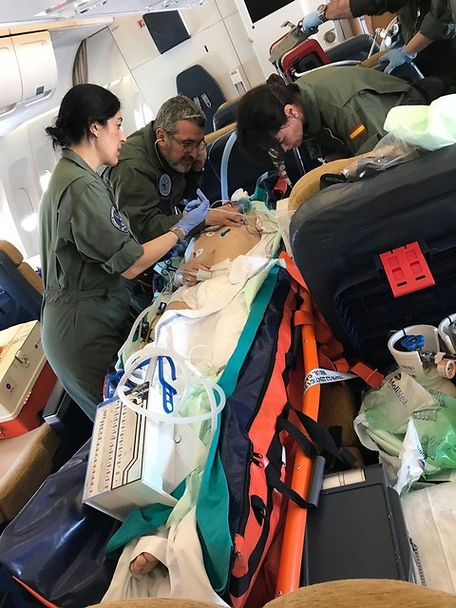
"In the UMAER, we are a team. When you get on a plane you are no longer a military rank but a member of a medical team where we are all equal and where each of us has our own mission," says Francisco Cantalejo (centre of the photo.) Courtesy of Francisco Cantalejo / UMAER
Transfer of critically ill patients and humanitarian missions by military transport aircraft
The UMAER has evacuated Ebola-infected patients in Sierra Leone and Liberia, assisted in the evacuation of thousands of Afghan refugees from Kabul during the airlift in 2021 and carried out numerous patient transfer missions affected by COVID-19.
"We perform about 40 missions a year. They are mostly medical aero-evacuations of between one and three patients, whether civilians or military personnel deployed on operation, but we also carry out international missions to respond to natural disasters or crisis situations," Francisco points out.
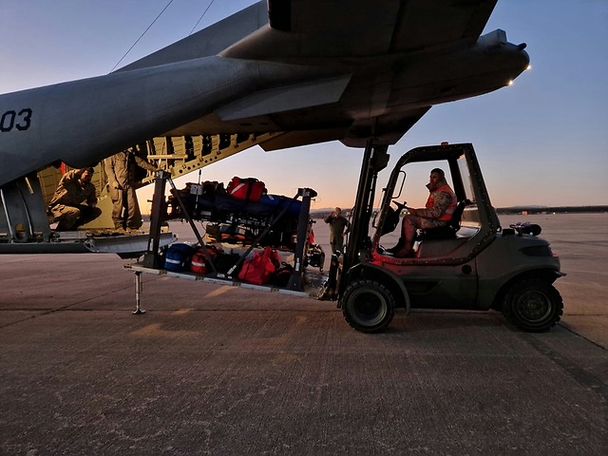
The UMAER prepares the aircraft and the material to be used in Medevac missions meticulously, with duplicates of material to face any eventuality. Courtesy of Francisco Cantalejo / UMAER
UMAER: on 24-hour alert, operational in just two hours
Whenever there is a request for assistance, the head of UMAR - Pilar Salvador - manages the availability of the aircraft and activates her team accordingly. For example, in a recent emergency of a patient with a time-dependent blood disorder pathology, an A400M was selected to fly from Iraq to Turkey, as only armored aircraft are allowed to land at Baghdad airport. An UMAER team then flew to Turkey to return the patient in a medicalised flight to Spain.
Francisco, as chief of operations, is in charge of assessing the clinical condition of the patient or persons to be evacuated and which personnel are needed; the medical officers on duty organise the material required for the mission - stretchers, electro-medical equipment, disposable bags, etc. - and the medical technicians prepare the aircraft's configuration and medicalised pallets.
The UMAER works in coordination with the Air Force's 45th Transport Group, 31st Wing and 35th Wing units and platforms such as the Airbus A400M, C295 and A310, as well as Falcon 900. The unit is also integrated into the European Air Transport Command (EATC), located in Eindhoven, which manages a shared fleet of aircraft from seven countries for air mobility and aero-evacuation missions within Europe.
"We are often called upon by the EATC, both because of our location in the southern part of Europe and because of our flexibility and capacity to react quickly," explains Francisco. "We are on standby 24 hours a day, seven days a week. From the moment we are activated, within an hour we are able to have an Intensive Surveillance Unit ready to mount on a C295 or A400M, with equipment structures weighing around 1,200 kilos, to be able to deploy for an evacuation mission in just two hours."
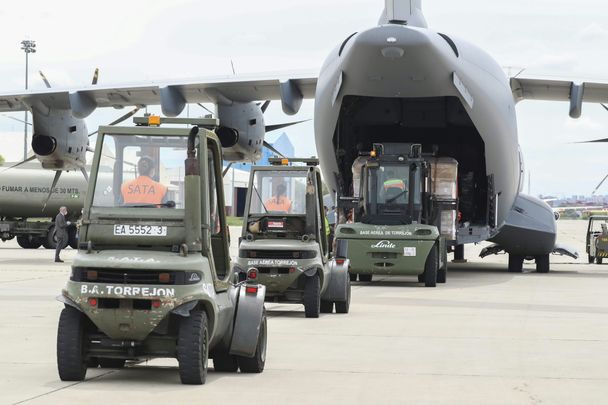
Numerous armed forces used the A400M (pictured here), A330 MRTT and C295 in Medevac and transport missions helping in the fight against the COVID-19.
The challenges of aero-medical evacuation
An anesthesiologist by training, Francisco has always felt that, "to be able to help in situations of maximum hospital emergency," was his thing. "Setting up an ICU on an airplane is exciting, but there is no room for you to become complacent, the work is different from any hospital facility. Patients are often in critical condition and can get worse just by moving around an air environment."
That's why factors such as ergonomics and accessibility are vital within a Medevac cabin.
Now, based on experience with other military aircraft such as the A400M and A330 MRTT, Airbus teams have developed a new Intensive Care Transport Module for the C295. "Our main objective is for it to be a low-cost, modular solution, allowing the same aircraft to be used for various types of missions, either with all the equipment as a mobile ICU or a more basic configuration," explains project lead Ángel Sánchez Franco, who is also head of C295 product policy and business development at Airbus Defence and Space.
The development of this mobile ICU is the result of Airbus' experience designing different types of Medevac solutions over the years and discussions held with UMAER and area forces such as the Portuguese or Czech. "We have integrated direct feedback from medical teams such as varying the placement of oxygen cylinders to stay out of the way or having a greater number of plugs. In addition, we have designed a new quick-attach mechanism so that the module can be quickly assembled and disassembled," says Ángel.
Airbus wants to make this innovation a solution that can be installed on all its military transport aircraft. "Versatility is the great advantage of the C295, a single platform allows you to do a multitude of different missions," says Ángel, who is in frequent contact with the aircraft's operators to respond to their needs. "In addition to passenger transport, the C295 can be quickly configured to transport cargo or for medical evacuation of patients, or equipped with a multitude of sensors for surveillance, search and rescue tasks".
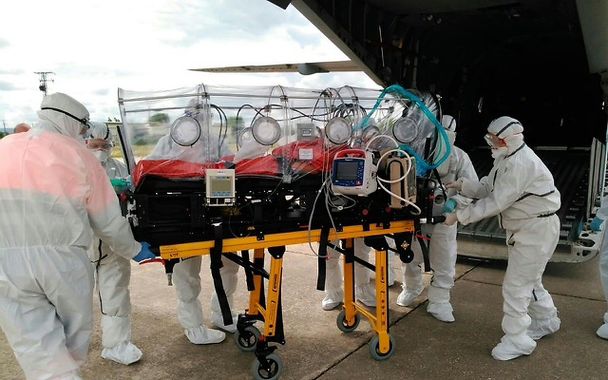
On medical evacuation flights, the UMAER transports oxygen for 12 extra hours if there is a hospital close to the base where the aircraft lands, or is extended to 24 extra hours if, on the other hand, the area of operations is conflictive or the weather forecast is adverse. Courtesy of Francisco Cantalejo / UMAER
Spanish Air Force: A vocation to serve the public
"In the UMAER, we are a team. When you get on a plane you are no longer a military rank but a member of a medical team where we are all equal and where each of us has our own mission," emphasises Francisco, who has been with the unit for more than 25 years. "There are moments at the end of a complex mission, when we are collecting the equipment from the aircraft, when we look at each other and we say to each other in a good way: 'what a crazy thing we have done'."
The emotional connection extends to patients as well, as evidenced by the fact that the UMAER team maintains contact with many of the people they have treated. "When you do evacuations of this kind, there are gestures that you don't forget: a look from a patient, the way they hold your hand, ask you to take them home... Sharing their joy when you bring them back is a very special emotion," says Francisco, recalling one of his first missions, the transfer of several children injured in the 1998 Omagh bombing in Northern Ireland. "Sometimes this work is very hard, because things don't always go well. But when you manage to save a life, the collective satisfaction is incredible. It's the best feeling in the world."
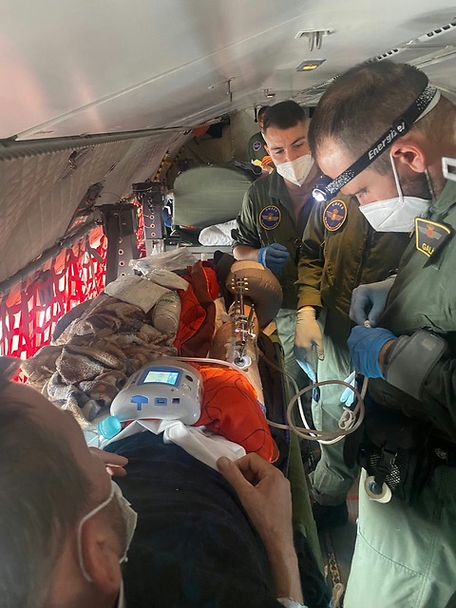
The UMAER prepares the aircraft and the material to be used in Medevac missions meticulously, with duplicates of material to face any eventuality. Courtesy of Francisco Cantalejo / UMAER
